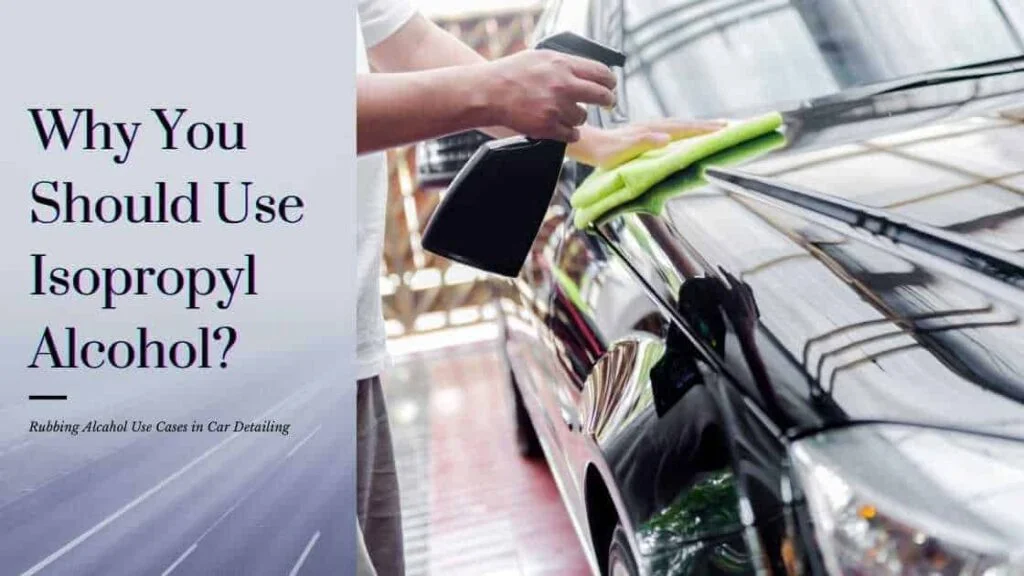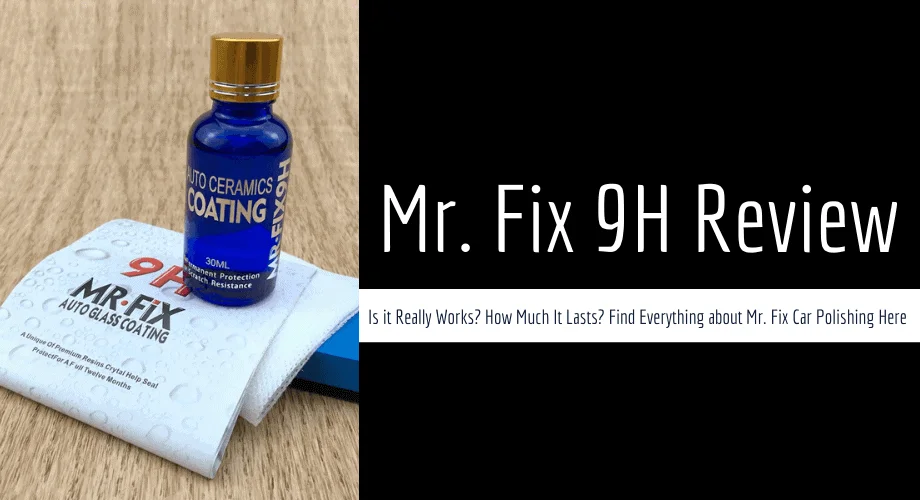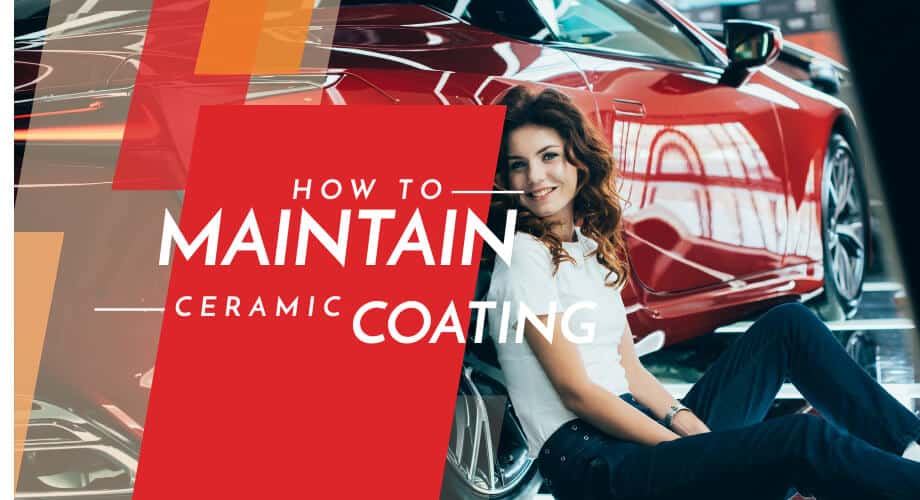Table of contents
You may have a large variety of car care products, but isopropyl alcohol is not commonly one of them. You may find Isopropanol or rubbing alcohol for first aid medical urgencies. Isopropyl Alcohol is a versatile product in the detailing world. Isopropyl Alcohol helps you retain the original surface of your vehicle when used with clays. Here, I’ll list a number of reasons why you would love to use this product.
Common uses of IPA that you may not know!
IPA is most commonly used to remove non-polar compounds, which are anything from fats to oils to gasoline, as opposed to nonpolar compounds like water or ammonia. And because of these properties, it is often used as a household cleaner ( cleaning grease clothes). It also removes the odour. Likewise, most detailers tend to use this product due to its cleaning properties to remove substances like wax or sealants.
1. REMOVES WAX OR SEALANTS FROM PAINTED SURFACES
This is the most common use of IPA when you want to remove the wax or sealant from the surface of your vehicle prior to polishing and compounding. It’s very necessary for any paint correction you may do since the surface of your vehicle should not have any oils, waxes, or residues.
You might also want to keep in mind that most car wash soaps do a good job at removing waxes every time you wash your vehicle, so using an IPA wipedown every time won’t be suggested. An IPA wash is necessary only before you apply the polish or ceramic coating. While you remove the scratches in certain parts of the vehicle, make sure that the products aren’t interacting with anything other than the clear coat. ( eg. Leftover waxes).
Recommended Concentration for IPA to use on Car & Motorcycle Paint Surface
Isopropyl Alcohol, commonly known as rubbing alcohol or clinical spirit, is readily available at your local medical store, pharmacy, or on Amazon for around ₹40 per 100 mL. It’s useful for removing compound or polish residue from your paint and preparing the surface before applying a ceramic or Graphene coating.
For optimal use, dilute the Isopropyl Alcohol to a 15% solution. Here’s how you can do it:
- If you purchase 70% Isopropyl Alcohol, add approximately 366 mL of purified water to 100 mL of the alcohol to achieve a 15% solution. This calculation works because 100 mL of 70% IPA contains 70 mL of pure alcohol, and diluting it to a total volume of approximately 466 mL yields a 15% concentration.
- If you have 100% pure IPA, dilute it by mixing 100 mL of IPA with about 566 mL of water. This will give you a total volume of approximately 666 mL, resulting in a 15% IPA solution.
Alternatively, refer to the following table for dilution ratios:
| Starting IPA Concentration | Amount of IPA (mL) | Amount of Water (mL) | Total Volume (mL) | Final IPA Concentration (%) |
| 100% IPA | 100 | 566 | 666 | 15% |
| 80% IPA | 100 | 433 | 533 | 15% |
| 70% IPA | 100 | 366 | 466 | 15% |
| 50% IPA | 100 | 233 | 333 | 15% |
Note: Never use Isopropyl Alcohol at full strength on automotive paint, and it is not recommended for freshly painted finishes. Your IPA solution is now ready! This will remove any wax, compound, or polish residue from the paint surface and prevent it from reacting with the coating.
2. REMOVES STICKER RESIDUE
When you detail a vehicle with an old bumper sticker or decal on the back glass, try to use the IPA. Other products like Goo-Gone also work well, but IPA is excellent for such applications. It’s being discovered that IPA helps the alcohol to penetrate into the pores of the paper, and it will naturally come off. Other products like Goof off contain acetone in them and are very strong too, it will strip the paint off from non-clear coated surfaces or rubber or vinyl surfaces. IPA is the safest option here
3. REMOVES RESIDUES OF POLISH
This is another good use of IPA. For example, once the polish is applied after compounding to remove a white scratch, the surface may appear blemish-free if the polish hides the scratch. When you use the IPA you can have a better estimation of what exactly is the final result. When using alcohol on counter polishes like Scratch Doctor, the scratches tend to disappear, but after a few weeks, the polish begins to wear off. You can check with one or two drops of the IPA solution to see that your compounding and polishing indeed remove the scratches
4. HEADLIGHT LENS RESTORATION
IPA can be used between stages to eliminate dust particles for most headlight restoration kits or DIY sandpaper alternatives. You can start with 300-400grit sandpaper, dried on UV costing, it’ll begin to come off and also leaves back dusty white chalk on the lens
IPA is mostly used as the last step to remove any compound or polish or dust that may be present on the headlight lens. It proves as a cleaning agent once the lens is clear before a UV coating is applied.
5. REMOVES HAZE FROM WINDSHIELD, WINDOW AND MIRROR
This is the safest and most effective use of IPA for nondetailers, as it is a very good method for clearing off an oily or waxy windshield without applying any products. Many detailing sprays just leave behind streaks, which could be due to oil residue present on the windshield. IPA is just great for clearing off all the oil that you may have failed to remove with other products Since you aren’t dealing with a clear coat, using IPA on clear surfaces like headlight and lens is not much big deal. You can mix it with little water to make it easy to apply.
CAN IT DAMAGE THE PAINT?
IPA solutions are safe for vehicles as long as they’re used properly with a proper ratio of water. Many people believe that IPA shouldn’t be applied on to freshly painted surfaces or on those with no clear coat, they believe it may cause the softening or swelling of the coat. When it’s diluted with water, all the risks are reduced significantly. It’s not big a deal as people think. Buy 100% pure IPA solution from your nearest Medical store and add 40% water to it. Your IPA solution to use on your vehicle is ready! If you couldn’t find a 100% IPA solution buy available rubbing alcahol and make sure that it contains only IPA and water (Preferably 60% IPA and 40% Water)
You’ll find out that IPA evaporate quite early and they do not contain any surfactant, it reduces the drag while applying it. That’s why you may also use water plus surfactant with their IPA mixtures. Water produces lubrication.
THINGS TO REMEMBER Before IPA Wipe
When incorporating isopropyl alcohol (IPA) into your car detailing routine, safety precautions are crucial to avoid accidents or damage. IPA is highly flammable, so always store and use it away from open flames, sparks, or heat sources. Work in a well-ventilated area to prevent the buildup of fumes, which can cause dizziness or irritation if inhaled in excess. While IPA is generally safe for short-term exposure, it can cause dryness or irritation when it comes into contact with your skin. To prevent this, wear nitrile or latex gloves during application. Additionally, avoid using IPA on certain materials like untreated plastics, rubber, or leather, as prolonged exposure may lead to discoloration, brittleness, or other forms of damage. For extra caution, test a small inconspicuous area before full application on sensitive surfaces.
Make sure you dilute it properly.
- The softer the clearcoat, the lower the percentage you should use
- Use it only on an as-needed basis in sections
- There’s no need to apply pressure to painted surfaces
- The alcohol percentage doesn’t matter if you dilute it correctly
- Do purchase a spray bottle and distilled water to use with the alcohol.
- Do not use undiluted IPA, as it’ll begin to eat off the clear coat over time.
Basically, thousands of people use the IPA in many ways. It serves a purpose for many detailers and car enthusiasts in one or another way.
Limitations of IPA in Car Detailing
While isopropyl alcohol is a versatile and reliable detailing product, it’s essential to recognize its limitations to avoid improper use. IPA is excellent for removing light residues such as oils, waxes, or polish remnants, but it is not designed to tackle tougher layers like ceramic coatings or heavy-duty sealants. Attempting to strip these materials with IPA can lead to frustration and insufficient results. For such tasks, mechanical polishing or specialized chemical removers are required. Additionally, IPA should not be used on certain delicate materials, such as vinyl wraps, untreated rubber, or painted plastic trims, as it may cause drying, cracking, or discoloration. Repeated use on these surfaces without proper care can lead to irreversible damage over time. Moreover, excessive reliance on IPA can also dry out paint if used in higher concentrations, making it essential to use it sparingly and as directed.
FAQ: Common Questions About IPA in Car Detailing
1. Can IPA be used on leather seats or dashboards?
No, IPA is not recommended for leather seats, dashboards, or any soft-touch interior surfaces. It can strip natural oils or coatings, leading to dryness and cracking. Use products specifically designed for these materials.
2. What’s the safest IPA concentration for general cleaning?
A 15% dilution (1 part 99% IPA to 6 parts distilled water) is the safest and gentlest option for general cleaning, especially on sensitive surfaces like glass or interior trims. This mild concentration reduces the risk of streaking and surface damage.
3. Does IPA work as a disinfectant for car interiors?
Yes, IPA with a concentration of 70% or higher is effective as a disinfectant. However, frequent use can dry out materials like vinyl or rubber. For interiors, use a diluted solution or a dedicated disinfectant product for long-term safety.
4. Is it safe to use IPA on chrome surfaces?
Yes, IPA can safely clean chrome surfaces and remove fingerprints or light residues. Ensure you use a diluted solution (around 15% to 30%) and a soft microfiber cloth to avoid scratches.
5. Can IPA remove adhesive residues from stickers?
Yes, IPA is highly effective at breaking down adhesive residues left by stickers or decals. For stubborn residues, use a 50% IPA solution and let it sit for a few seconds before wiping clean.
6. Does IPA damage car paint?
When used at safe dilutions (15%-50%) and wiped off quickly, IPA does not damage car paint. However, avoid prolonged exposure or rubbing aggressively, as it may dull the finish or dry out the paint surface.
7. How often can I use IPA on my car?
Limit IPA usage to specific tasks, such as surface prep before applying ceramic coating or removing wax. Frequent use, especially at higher concentrations, can dry out or harm certain surfaces over time.
8. What’s the best IPA solution for removing wax or sealants?
For wax or sealant removal, use a 50% IPA solution (1 part 99% IPA to 1 part distilled water). This concentration effectively breaks down oily residues without being too harsh on the paint.
9. Can IPA clean oil or grease stains?
Yes, IPA is excellent at cutting through oil and grease stains on painted or metallic surfaces. Use a 70% solution for tougher stains but ensure you wipe the area clean to avoid streaking.
10. Is IPA safe for tinted windows?
Yes, IPA is safe for tinted windows when diluted to 15% or less. This gentle concentration prevents damage to the tint film adhesive while effectively cleaning the surface.
11. How should I store IPA?
Store IPA in a cool, dry place away from direct sunlight and heat sources. Use an airtight container to prevent evaporation, and ensure it is kept out of reach of children or pets due to its flammability and toxicity.
12. Can IPA remove hard water spots from glass?
IPA can help remove light hard water spots on glass when used at a 15%-30% dilution. For tougher spots, use a dedicated hard water remover or a mixture of vinegar and water.
13. Is IPA better than panel wipes for ceramic coating prep?
IPA is a cost-effective alternative to panel wipes, but dedicated panel wipes are often formulated for enhanced cleaning and leave no residues. If you’re applying a premium ceramic coating, consider panel wipes for better performance.
14. What type of cloth should I use with IPA?
Always use a clean, lint-free microfiber cloth for IPA applications. This prevents scratches and ensures a streak-free finish.
15. Can IPA be mixed with other cleaning agents?
No, IPA should not be mixed with other chemicals or cleaning agents, as this can result in harmful reactions or diminish its effectiveness. Use it as a standalone solution diluted with distilled water.






Yes, some dealerships polish and wax your vehicle prior to delivery. IPA assists in removing polishing residue and preparing the surface for ceramic coating.
Is it necessary for a brand new car to wipe with IPA before a ceramic coat?
Very useful. Many thanks. Simply i would have wasted money on pre application wipes
Ceramic coating can’t be removed using isopropyl alcohol. A machine polishing will help to remove the ceramic coating completely, if you want to remove any high spots I recommend using Marine Paste Ceramic Coating Remover.
Can ceramic coating be removed by isopropyl alcohol ? Can paint surface be cleaned with spirit after coating ?